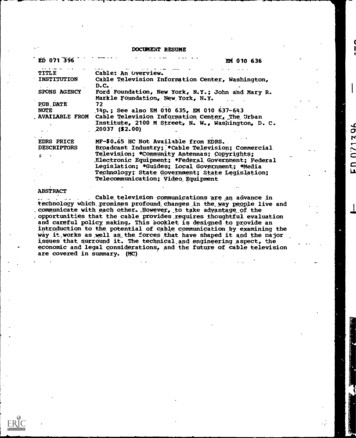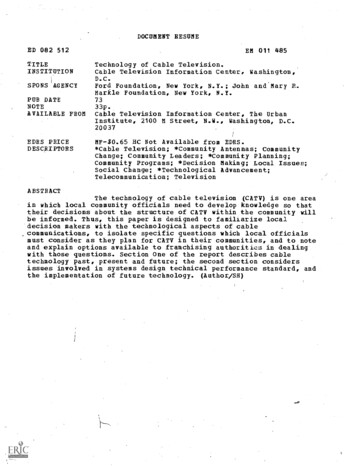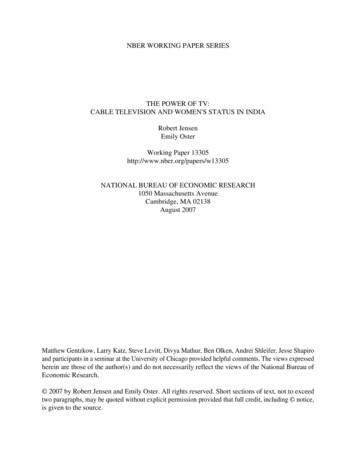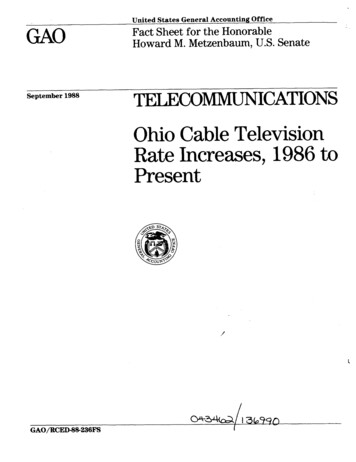
Transcription
DOCUMENT RESUMEtED 071EM 010 636.TITLEINSTITUTION.Cable: An Overview.Cable Television Information Center, Washington,D.C.SPONS AGENCYRUB. DATENOTEAVAILABLE FROMEDRS PRICEDESCRIPTORSFord Foundation, New York, N.Y.; John and Mary R.Markle Foundation, New. York, N.Y.7214p.; See also EM 010 635, EM 010 637-643cable Television InfgrMation Center,. The UrbanInstitute, 2100 M Street, N. W., Washington, D. C.20037 ( 2.00)MF- 0.65 AC Not Available from EDRS.Broadcast Industry;:*Cable Television; CommercialTelevision; *Community Antennas; Copyrights;Electronic Equipment; *Federal. GoVernment; FederalLegislation; *Guides; Local. Government; *MediaTechnology; State Government; State Legislation;Telecommunication; Video EquipmentABSTRACTCable television communications Are an advance intechnology which.promises profound.ohanges.in the way people live andcommunicate with each other.,However,.to take advantage of theopportunities that the cable provides. requires thoughtful evaluationAnd careful policy making. This booklet is designed to provide anintroduction to the potential of cable communication by examining theway it -works as well as the. forces that have shaped it and the majorissues that surround it. The technical.and engineering ,aspect, theeconomic and legal considerations, and the future of cable televisionare covered in summary. (MC).-are
Cable TelevisionInformation Centerthe urban institute1Cable: An Overview
-7,'PERMISSION TO REPRODUCE THIS COPYRIGHTED MATERIAL BY MICROFICHE ONLYHAS BEEN GRANTEO BYE.OnTO ERIC ANO ORGANIZATIONS OPERATINGUNDER AGREEMENTS WITH THE US OFTICEOF EDUCATION FURTHER REPRODUCTIONOUTSIDE THE ERIC SYSTEM REQUIRES PERMISSION OF THE COPYRIGHT OWNERCopyright 01972 by Cable Television InformationCcnter. All rights reserved. No part of this documentmay be used or reproduced in any manner whatsoeverwithout written permission except in the case of briefquotations embodied in critical articles and reviews.For information address: Cable Television Information Center, 2100 M Street, N.W., Washington, D.C.20037. Att: Information Group.
PREFACEThis document was prepared by the Cable Television Information Centerunder grants from the Ford Foundation and the John and Mary R. MarkleFoundation to The Urban Institute.The primary function of the center's publications program is to providepolicy makers in local and state governments with the information andanalytical tools required to arrive at optimum policies and procedure for thedevelopment of cable television in the public interest.[
ACKNOWLEDGMENTSaiCThe center is indebted to Rob Stengel, Director of Public Relations,National Cable Television Association, and Harvey D. Shapiro, VisitingINFellow at the Russell Sage Foundation.Ct-CLi:.
.CABLE: AN OVERVIEWU.S DEPARTMENT DF HEALTH,EDUCATION & WELFAREDFFICE OF EDUCATIONTHIS DOCUMENT HAS BEEN REPRO.DUCED EXACTLY AS RECEIVED FROMTHE PERSON OR ORGANIZATION ORIGINA-ONG 17 POINTS OF VIEW OR OPIN-IONS STATED DO NOT NECESSARILYREPRESENT OFFICIAL OFFICE OF EDUCATION POSITION OR POLICYi1AN CABLE TELEVISION INFORMATION CENTERThe Urban Institute2100 M Street, N.W., Washington, D.C. 20037r
5Cable: An OverviewINTRODUCTION. . CA TV could change the country's way of life. Itscopper. coaxial cables, though larger than telephonecord, have 1,000 times the communications capacity.Washington willing, the U.S. could be transformedinto what some call 'the wired nation." Within tenyears, CATV's two-way conduits could provide setside shopping and banking, dial-a-movie service, aburglar and fire watch, and facsimile print-outs ofnewspapers or even library books.Time Magazine, June 1, 1970Cable communications is an advance in technologywhich promises profound changes in the way people liveand communicate with each other. It can be a uniquetechnological advance if society accepts its opportunityto shape and control cable before it becomes fixed inplace.This century has seen the introduction of severalmajor technological innovations, including the automobile, the electronic computer, and television, whichhave altered our lives in many ways. Instead of maki.igconscious, explicit decisions about the development ofthese devices, however, too often American society hasallowed technology to work ;ts own way, forcing unintended and undesired consequences on us.Now cable television looms on the horizon, offering apotential for change comparable to these earlier innova-tions. Currently cable TV subscribers in a number ofareas are receiving better television reception and accessto more channels. But the promise of broadband cablecommunications is its capacity to carry more kinds ofmessages faster than existing means of communicationand its capacity for two-way communication. Thus, itIt could have an effect comparable to the computer intransforming commerce and research, and changing theway we store and retrieve information.Moreover, cable communications promises to becomea new industry which will require large capital investments, employ thousands of men and women, andgenerate considerable profits, while altering existingpatterns of commerce and employment.Thus, cable communications may reshape urban life,but not automatically to )ur advantage. One studysuggests that educatior,21 programming on the cable canhelp rebuild ghetto communities,' while anotherspeculates that cable could further divide and isolatepeople by race and geography.2 While some observerssee it as a means of providing new services in everyone'shome, others fear it may stifle personal contact and limitthe human interaction that is such an important part ofurban life.Like the automobile or airplane or computer, cablecommunications can have positive or negative social con-sequences, depending on how we deal with it. Whatdistinguishes cable communications from earlier technological innovations is that its potential impact hasbeen recognized. We have the opportunity to establishground rules that will control the direction and maximize the benefits of cable communications. To takeadvantage of this opportunity, however, requiresthoughtful evaluation and careful policy-making.Cable: An Overview is designed to provide an introduction to the potential of cable communications byexamining the way it works as well as the forces thathave shaped it and the major issues that surround it.raises the prospect of a vast array of new kinds ofservices.Cable could decentralize television programming andbroadcasting, enabling new voices to speak to newaudiences. It promises to facilitate selection of merchandise at home. The Sloan Commission on CableCommunications predicted a critical role for cable as adelivery system for such important public services aseducation, health care, and sampling political opinions.Equipped with a pririt-out device, cable could provide ameans of delivering mail and distributing reading matter.' H.S. Dordick et.al., Telecommunications in Urban Development (Santa Monica, California: Rand Corporation, July 1969),p. 61.2 N.E. Feldman, Cable Television: Opportunities and Problems in Local Program Origination (Santa Monica, California:Rand Corporation, September 1970), p. 24.
6HOW CABLE WORKSTechnology has always been CA TV's strongest asset,and the more forward-looking members of theindustry anticipate that CA TV will revolutionize notonly television, but all of electronic communications.National Observer, July 7, 1969Cable communications differs from broadcast telein that its signals are sent over a network ofcoaxial cables instead of being transmitted through theair. This difference in the method of transmission notonly provides better television reception and access tomore channels, it also holds the potential for specialvision(5 - 54 MHz) which is now used for mobile communications. Moreover, the super band, the spectrum spaceabove 216 MHz, is now used for aeronautical and mobilecommunications and UHF television. With set convertersthese frequencies can also be used to carry televisionchannels on the cable.Because cable television can theoretically offer analmost unlimited number of channels with clear reception, it has been called "the television of abundance."Yet its broad band width enables coaxial cable to facilitateother kinds of communications as well. Voice and dataImpulses sent through the air from a television transmitter are often deflected by tall buildings andmountains and weakened by distance: so that receptionvaries among homes. Transmission by cable provideschannels, for example, require much less spectrum spacethan television. A two-way data channel, which can poll20,000 to 30,000 homes every few seconds to see if theywish to initiate communications, requires only four MHzof spectrum space. Moreover, cable systems can alsotransmit FM radio signals, since the entire FM portion ofthe electromagnetic spectrum lies between televisiontelevision signals with a controlled path to the receiver,channels six and seven.programming and special services.apath which is protected against interference fromobstacles and other signals in the air and which isamplified to maintain its strength over long distances, soreception is uniformly good.Cable communications also provides more televisionchannels than broadcast television since it allows use ofchannels that are adjacent to each other without signalinterference. Broadcast television can rarely allow morethan seven of the 13 VHF channels to operate in anyone city, because of the scarcity of channel space in theelectromagnetic spectrum. Electromagnetic waves ofabout the same frequency will interfere with each otheras they travel through the air, distorting the TV picture.Thus, when the Federal Communications Commissionallocates channels, it cannot allow broadcasters to usadjacent channels in the same area because of this "cochannel interference."Moreover, television has dozens of competitors forelectromagnetic spectrum space, such as radar and othermilitary transmiss:ons, meterological aids, aeronauticaland maritime navigation and police radios. All of theseuses are expanding, creating heavy demand for scarcechannel space. Unlike these others, television, whichoccupies 53 per cent of the most useful frequencies ofthe spectrum, can use cable instead of the airwaves.Transmitting television signals by cable not only freesmuch of the spectrum for alternative uses and largelyWhile cable systems differ in many respects, all havecertain universal features. The system's three basiccomponents are the headend, the cable network, and theterminal.The HeadendAt one end of the system is the headend, where tele-.vision signals are originated or picked up from the air byantennas or microwave receivers. These signals are thenprocessed, amplified and sent down the eagle. The headendfacility may include channel processors whichreceive signals from local over-the-air television stationsas well as microwave antennas and demodulating equipment for receiving signals from great distances. If someprogramming is produced locally, the headend is con-nected to the studio equipment and television modulators./The Cable NetworkOn the outside, coaxial cable looks something liketelephone wire. It has a narrow inner conductor, made ofcopper wire, a larger outer conductor made of extrudedaluminum, and a layer of plastic foam that keeps themJACKET--,.,OUTERCONDUCTOReliminates signal interference, it also provides access tomore television channels.In addition to the portion of the spectrum allocatedto VHF television (54 - 88 megahertz (MHz) and174 - 216 MHz) cable can carry the frequencies thatbroadcast television cannot use. A cable system can usethe mid band frequencies (108 to 174 MHz) which arecurrently used for aeronautical and mobile communica-tions, and it can also transmit data on the sub bandSOLID FOAM ORAIR DIELECTRICINNER CONDUCTOR/-.
7apart and maintains an electric field between them. Anouter plastic sheath protects the cable from weather orwhatever else might affect the system's operation.After the distant broadcast signals are received orlocal ones originated, they are strergthened, convertedto the proper frequencies, and distributed over the cablethrough what is sometimes referred to as a "trunk-Performance standicJs limit the number of amplifiersthat can be connected in line on one coaxial cable toabout 25 trunk amplifiers, spaced 2.8 amplifiers per mileof 3/4-inch cable. This rule of thumb implies that trunklines cannot extend more than approximately eight milesfrom each headend without unacceptable loss of signalquality.branch" system.The TerminalThe home terminal is at the end of a cable system. Inits simplest form, the terminal consists of a television setand connectors that join it to the coaxial cable. But withthe advent of new cable services, a home terminal mightinclude more complex equipment, such as set converters.A converter extends the capacity of a conventionalhome receiver beyond the 12 VHF channels, andprotects the receiver against interference from stronglocal over-the-air signals. The converter also transformsall channel frequencies coming in on the cable to a singlefrequency, an unused channel on the VHF dial. The subscriber sets the dial on that channel number and selectscable channels by using a tuner knob on the converter.The cable that leaves the headend, called the trunkline, is about one-half to three-quarters of an inch indiameter. To distribute the cable to subscribers' homes,the trunk line is connected to smaller feeder lines.Finally, individual drop lines run into each household.If coaxial cables are strung above gee Lind they areusually suspended on poles belonging to the telephoneor power companies, which arc rented to the cableoperator at negotiated rates.The cable may either be buried directly in theground, run through submerged plastic pipes or includedin underground utility conduits. Although undergroundconstruction is almost always more expensive, somecommunities require it to protect the appearance of thetown.Amplifiers are inserted about every two thousand feetThroughout the distribution plant to keep the signalsfrom losing strength.'/Another solution to the limitations of television receivers is to install two cables and a simple switch so thatsubscribers can select channels from either cable. Thisapproach expands channel capacity without a converter.In the future, the Rand report on interactive television suggests, a terminal may also include a videotaperecorder; a facsmile receiver to receive and print outnewspapers or third class mail that is "delivered" bycable; an alphanumeric keyboard to send messages backto the headend; and a computer control center to keeptrack of the sending and receiving of information.TwoWay CommunicationsUsing a separate cable, or different frequencies on thesame cable, signals can also be sent from the terminalback to the headend, or, eventually, among the subscriber terminals. The FCC has required some form ofsend-and-receive or two-way capacity for all new cablesystems in the top 100 television markets.Cable communications is well suited for rapid twoway interaction between many subscribers and a centralinformation processor, an arrangement that would beuseful in opinion polling, market research, meter reading, and other processes that require only small amountsof return data. These will probably be the first kinds oftwo-way cable made available to the public.The ultimate extension of two-way cable is simultaneous, two-way video, such as that required for videophones. At this point, the switching equipment requiredis prohibitively expensive, and even the ample bandwidth of coaxial cable would be hard pressed to providesufficient television channels for private use in a typicalcable system.
rrr8To date, only a few small communities and small sections of larger cities offer two-way capacity, and theseare largely experimental. Manufacturers have yet to massproduce reliable equipment for two-way cable. Anotherfactor which has slowed the adoption of two-way cableis economics. It is not clear what two-way will cost orhow many people will be willing to pay for it. One RandCorporation study estimates that adding two-waycapacity to a single cable.system would add 15 to 30 percent to the capital cost of a one-way system.IA Mitre Corporation report on urban cable systems,fin-a-tliarsubscriber response services will almost doubleTHE ECONOMIC AND LEGAL FRAMEWORK. . the Tcsk Force believes that cable televisionoffers the most promising solution to a number ofdifficult problems facing our larger cities. It can solvethe problem of interference with television reception.It can ease the crowding of the electromagnetic spec-trum, which is already referred to as "the silentcrisis." It can provide a multiplicity of channels tohelp meet the expanding needs of a modern urbansociety for channel space.Mayor's Advisory Task Force onTelecommunications in New YorkCity, September 1968the cost of one-way cable.2Individual subscrK:Jr terminals for two-way operationnow cost between 200 and 300. Although costs willfall as the production of terminals increases, for the nextthree years the price is not expected to drop below 100to 250 for each user in a 5,000 terminal system.3Interconnection of SystemsAnother important development in cable technology,one which seems closer than complete two-way tram,mission, is the interconnection of cable systems toprovide a variety of networks for distributing program.ming regionally or nationally. Ad hoc groups of cableTV systems could easily arrange to carry a particularprogram of common interest to their subscribers. Someheadends can be interconnected through microwave orcable relay systems, but the most promising form ofinterconnection for the immediate future appears to bedomestic communications satellites.Satellites, once launched, would make availal:le a fargreater degree of interconnection at about half .he costof more traditional means of interconnection, accordingto the 1971 report of the Sloan Commission on CableCommunications.4 Several aeronautical and communica-tions corporations have applied to the FCC for permission to build the first such satellite, which will serve asubstantial number of cable systems through groundreceiver stations at or near their headends. Programminginterconnection by satellite is expected to be in operation by 1974 to 1975.The OriginsThe first cable systems were simple ones. They werebuilt in Pennsylvania and Oregon in the late 1940s tobring television signals to isolated communities whereTV reception was blocked by mountains or weakened bydistance.In these communities, an enterprising operator woulderect an antenna on a tower, high building, or mountainto catch broadcast signals and connect his antenna to acoaxial cable which was linked to tile homes of subscribers who paid a monthly fee. Cable provided clearreception, and in some areas offered the added service oftelevision signals from more than one city. This systemwas called Community Antenna Television, or CATV.The first cable operators, usually local businessmen,had few restrictions on their new enterprises. Theyabsorbed high depreciation costs as tax losses in theearly years of the system's operation, creating a highlyprofitable business in later years.The FCC chose to exercise no authority over cable,and most state governments took no notice of the newtechnology, so local governments were the only regulators of cable television during its first decade. Theybecame involved because cable operators distributedtheir cables over public property and needed permissionto use rights-of-way. Since cable TV was regarded as aservice to their residents, municipalities routinelygranted cable operators permission to build theirantennas and cable lines.The broadcast television industry, itself a relativenewcomer then, also paid little attention to cable. Infact, television stations welcomed cable systems as a1 Walter F. Baer, Interactive Television: Prospects for TwoWay Services on Cable (Santa Monica, California: Rand Corporation, November 1971), p. 56.2 William F. Mason, et. al., Urban Cable Systems (McLean,Virginia: The Mitre Corporation, May 1972), p. 11.41.'Baer, interactive Television, p. 58.4Sloan Commission on Cable Communications, Report of theCommission, On the Cable: The Television of Abundance (NewYork: McGraw Hill Book Company, 1971), p. 42.means of extending their service areas and increasing thesize of their viewing audiences.At first, cable operators offered their subscribers onlyone or two, then five, channels of CATV. Even with thislimited service, cable television spread rapidly to smaiitowns thro"ghout the country. In 1952, there were 70cable TV systems with 14,000 subscribers; 10 yearslater, according to Television Digest, there were 8001
9systems with 850,000 subscribers. Though still a smallindustry, cable TV was a largely unfettered one until the1960s when cable technology became more sophisticated and the growing industry attracteci more attention.treasuries, and they soon were demanding a share of thecable system profits. Usually the fee amounted to threeor four per cent of total gross subscriber receipts, butone system in Colorado pays from five35 per cent onExpansiona sliding scale based on a gross income, and a fewIn the early 1960s the introduction of channel processors and other new techniques which allowedadjacent channels to be carried on the cable increasedthe potential channel capacity of a CATV system to 12channels. The development of wideband solid stateamplifiers raised channel capacity to 20 channels at theend of the (made. Most systems began to carry UHFand VHF signals from one or two other cities ("distantsignals") besides the signals from the nearest televisionstations.Dozens of systems also began to offer some form oflocally originated programming. Usually it was auto-systems pay even more. Some municipalities requiredliability insurance for injury, property damage and copyright infringement. Others required 'free cable installa-tion for municipal buildings as a substitute for directrevenue.Special. interest groups also helped shape cable TVfranchises. Theater owners in some cities, for example,fought for, and won, clauses which prohibited pay television. Blackouts of local sports events were written intosome city franchises where team owners feared thatgames televised on cable or over-the-air would cut intotheir gate receipts.matic origination such as news and stock market tickers,In the early stages of cable franchising, there was stillmusic, or time and weather information, but somelittle consideration of many basic features of cablesystems also cablecast local news or advertisemlnts.By 1965, Television Factbook recorded 1,325operations, such as the number of channels, subscriberrates, program origination, and construction schedules.As a result, many ordinances contained serious flaws.operating systems with 1,275,000 cable subscribers.Although cable TV was still mostly a rural and smalltown phenomenon, many cable operators were lookingtowards the cities, where almost 90 per cent of theeeLocal officials often granted franchises hastily; thesefranchises frequently ran for 25 years or longer, whileimposing few affirmative requirements upon the opera-potential audience lived.The structure of the industry was also evolving duringtor. Once a franchise was awarded for a lengthy period,cities lost their bargaining power and their contr& overthe 1960s as small, individually-owned cable systemsbegan to be subsumed by chains of cable systems.Multiple system operators (MSO's) bought out smallcable operators and merged with each other, so rapidlythat irk 1972, a National able Tele sion Association(NCTA) survey estimated that only one-quarter of allthe cable system.cable TV subscribers were served by individually-ownedsystems.Almost 60 per cent of the nation's subscribers areserved by systems owned by the 25 largest MSO's, whichalso frequently own or supply other communicationsmedia: newspapers, radio and television stations, maga-zines. Suppliers and distributors of programming forcable systems have also tended to merge into larger corporations.Local RegulationThe changes in the nature of the industry have led tocorresponding changes iv the kinds of governmentregulation developed for cable television, and to changesin the attitudes of other inducti its. As cable technologybecame more sophisticated in the early 1960s many cityofficials came to realize that there was more to gainfrom their CATV franchises than additional televisionshows for their citizens.Since cable was a profitable, rapidly expanding business, cities began to recognize cable franchises aspotential sources of revenue for their hard-pressedBecause some franchises didn't include constructiontimetables, some franchise holders delayed or never evenbegan building the systems, preferring to buy and sellfranchises like investment securities. In some cities,operators were free to wire the more affluent sectionsand bypass poor neighborhoods. Many systems wereallowed to install limited capacity and omit local programming. There was generally no mechanism for consumer complaints.This period of local control over cable's developmentalso was marred by corruption in the seeking and award-ing of franchises. In one instance, an officer of a largenational cable company was convicted of bribing localofficials to win franchise rights. Several local officialswere accused of accepting the bribes.More recently, local authorities have come to understand the importance of sound decisions on cable televi-sion and their responsibility in helping to make them.Cities frequently establish study committees to gaugelocal cable needs and recommend procedures for meeting them. Franchise awards have become distinctly moredeliberate, the process of studying cable, writing an ordinance and awarding franchises often taking a year orlonger. Finally, a combination of federal regulation andincreased public awareness have led to fuller communityparticipation in cable decisions.
10Federal Regulationand adopted rules goyerning their pracAces. TheThe growth of the cable industry began to concernbroadcasting and other industries which saw their corSupreme Court, in its 1968 Southwestern3 decision, supportzd the FCC's authority over cable television as longmerical territory being invaded by cable. Local televisionasit was "reasonably ancillary to the effective per-to outbid them for programming. Broadcasters alsoformance of the Commission's various responsibilitiesfor the regulation of broadcasting ."The Second Report and Order in effect prohibitedimporting distant signals to the top 100 markets, thusremoving one of cable television's primary attractionsfor urban viewers. From that time until March .1972,when the FCC issued its Third Report and Order, cablecompanies stayed out of nearly all big cities. Withoutdistant signals to provide attractive programming, thecity markets were considered unlikely to support newclaimed that cable operators enjoyed the advantage ofnot paying copyright fees for the programs they carried.cable television systems.The FCC seemed to alter its approach in the MidwestThe growing pressure for regulation of the cableVideo case and in its Third Report and Order. In theMidwest Video decision in October 1969, the FCC required cable systems with more than 3,500 subscribersstation owners feared that cable systems would lureaway their viewers, cutting their audience size andadvertising r' venues. Small UHF stations, in particular,claimed they would fail if viewers deserted them for thebetter reception and greater program diversity of cableTV.Large broadcast groups and networks were not onlyconcerned bout the financial health of their local affiliates but wereirried that cable systems might combineindustry led the Federal Communications Commissionto exercise steadily increasing authority over cable communications.The FCC was established by the Communidations Actof 1934 to regulate interstate and foreign commerce incommunications.It must allocate frequencies to ensure that radiatedsignals do not interfere with each other in the crowdedelectromagnetic spectrum. In addition, the commissionis charged with ensuring "the widest possible dissemination of information from diverse and antagonisticsources."1Because even early cable systems could carry five to12 channels without signal interference, the need'forfederal regulation of CATV did not seem appatent. Aslate as April 1959, the FCC still found no basis to assertits authority over cable television systems.The first step towards federal regulation came in1962. In the Carter Mountain2 ruling, the FCC prohibited microwave companies from relaying distant television signals to CATV systems when they would duplicate the programming of local television stations. Thisprotection of VHF and UHF broadcasters from competi-tion by cable was a recurrent motive in FCC rulingsduring the 1960s.In April 1965, the FCC issued its First Report andOrder on cable television, asserting jurisdiction overmicrowavefed systems. I n accordance with its beliefthat CATV should supplement, not replace, broad,asting, the commission recommended "a reasonablemeasure of exclusivity" to protect program suppliers andtelevision stations.In its Second Report and Order, issued the followingyear, the FCC claimed jurisdiction over all cable systems'Associated Press v. U.S., 326 U.S. 1 at 20 (1945).'Carter Mountain Transmission Corp. v. Federal Communica-tions Commission, 361 F. 2d 359, certiorari denied, 375 US.134.to originate some programming, which could be finar.zedby advertising in natural program breaks. The SupremeCourt upheld this ruling in 1972.4In March of 1972, the FCC completed its ThirdReport and Order, caliA the Final Cable TelevisionDecision at the time of its release. This governed variousaspects of cable television, inducing
Currently cable TV subscribers in a number of. areas are receiving better television reception and access. to more channels. But the promise of broadband cable . The cable that leaves the headend, called the trunk line, is about one-half to three-quarters of an inch in diameter. To distribute the cable to subscribers' homes,










